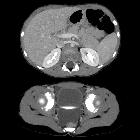Revised Atlanta classification of acute pancreatitis



The Revised Atlanta classification of acute pancreatitis from 2012 is an international multidisciplinary classification of the severity of acute pancreatitis, updating the 1992 Atlanta classification.
The worldwide consensus aims for an internationally agreed-upon classification of acute pancreatitis severity, with standardized terminology for pancreatitis and its complications.
Classification
The classification system is based on both local and systemic determinants of severity, with:
- local determinants related to the presence or absence of
- (peri)pancreatic necrosis
- sterile or infected
- (peri)pancreatic necrosis
- systemic determinants related to the presence or absence of
- organ failure
- transient or persistent
- organ failure
The grade of severity (mild, moderate, severe, and critical) is based on combinations of these determinants.
Furthermore, discrimination was made between two clinical phases of pancreatitis:
- early (1 week): in which severity is based on the presence or absence of systemic organ failure
- late (>1 week): in which severity is based on the presence of local complication or persistent systemic organ failure
The Atlanta classification divides acute pancreatitis into two basic types:
- interstitial edematous pancreatitis (IEP)
- necrotizing pancreatitis (NP) which is further subdivided into:
- parenchymal necrosis
- peripancreatic necrosis
- combined type (peripancreatic and parenchymal necrosis): most common
All types of necrotizing pancreatitis may be sterile or infected; gas formation is the best imaging feature to suggest infection.
Treatment decisions in the late phase rely heavily on morphologic criteria. The role of the radiologist is to aid in treatment planning by correctly addressing the morphologic changes.
New terminology for fluid collections associated with acute pancreatitis is introduced :
- fluid collections associated with interstitial edematous pancreatitis (i.e. minimal or no necrosis)
- acute peripancreatic fluid collections (APFC): in the first 4 weeks: non-encapsulated peripancreatic fluid collections
- pseudocysts: develop after 4 weeks; encapsulated peripancreatic or remote fluid collections
- fluid collections associated with necrotizing pancreatitis
- acute necrotic collections (ANCs): in the first 4 weeks; non-encapsulated heterogeneous non-liquefied material
- walled-off (pancreatic) necrosis (WON or WOPN): develop after 4 weeks; encapsulated heterogeneous non-liquefied material
ANCs and WONs are collections that contain both fluid and necrotic material of various amounts (an important point to differentiate them from APFCs and pseudocysts, however, in indeterminate cases follow-up is recommended).
The terms pancreatic abscess and intrapancreatic pseudocyst are totally abandoned in this new classification.
Siehe auch:

 Assoziationen und Differentialdiagnosen zu Pankreasabszess:
Assoziationen und Differentialdiagnosen zu Pankreasabszess:





